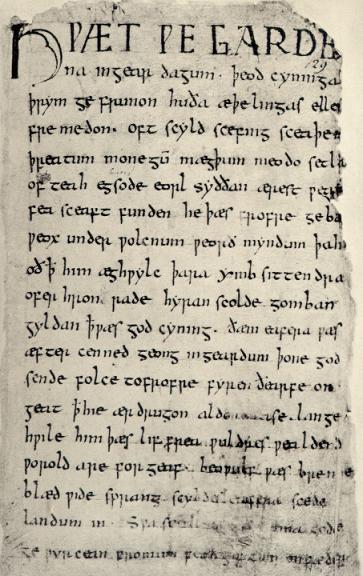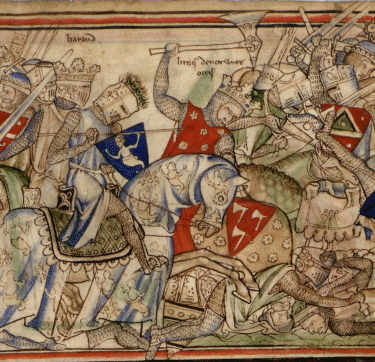The English language is Germanic in origin, although over half of its words have derived from contact with the Latin and French languages and some from Scandinavian influence.
English has spread across the globe and is now the first language of over 50 countries and the world’s most commonly spoken second language.
The British Isles have been inhabited for over 50,000 years. Knowledge of the British languages during this earlier time in British history is limited, however, it was the arrival of the Celts some 3000 years ago that saw the development of the languages in Britain that we can trace today.
This Celtic influence on British language is still evident in modern times in the Welsh spoken in Wales and the Gaelic spoken in Scotland and in Ireland.
The British Isles was inhabited by Celtic and Roman peoples before the arrival of the Germanic tribes who brought with them the language that developed into what we call English.
Old English (c. 450 – 1100)
Old English is the term we use to describe the English language from c. 450 – 1100.
Our modern English is very different from Old English. The language has undergone many changes with its development taking place over 1500 years.
Although Latin held a strong influence throughout the Roman’s rule, the language of English officially started in 449 with the arrival of the Germanic tribes. The words ‘English’ and ‘England’ derive from one of these tribes, the ‘Angles’.
Words from North Germanic origin also flooded into the English language, especially in the north of England, due to the Viking invasions, which started in around 850. This was a main influence on the creation and development of the Old English language.
The Vikings domination of England was stopped by King Alfred the Great (871 – 900) and the most of the invaders ended up settling down with the English people and adopting Christianity.
Grammar of Old English
Much of the Old English language surviving today uses gender in nouns, while word order was not fixed and there was a lot of freedom in the way the language was used.
Old English grammar is similar to the grammar of modern German with different inflectional endings, four distinctive cases (nominative, dative, accusative and genitive) and gendered nouns.
Another similarity with modern German was that Old English often moved the verb to the end of the sentence in subordinate clauses.
Other distinctive parts of Old English grammar included: the absence of a word for ‘do’ when forming questions, a large number of double negatives (as found in modern Spanish), no distinction between the letters V and U in the written form and an absence of the letters J and W.
The Influence of the Church on Old English
In the late 6th century, the Anglo-Saxons embraced Latin Christianity. One of the big cultural shifts of this time was the introduction of parchment, which was used for record-keeping within the Church.
Before this time, all writing tended to be simple, short engravings made on either wood or bone, with the earliest Anglo-Saxon inscriptions dating from around 450.
With the invention of parchment, longer texts could be written down, while virtually all the examples of Old English surviving today can be found through the Church. The earliest Anglo Saxon written texts date from the late 7th century.
Old English Literature
Texts written in Old English language consist of poetry, prose, maxims and proverbs. Much of it was based on the Bible and Pagan traditions. The texts are hard to date and rarely have an author’s name attached. The earliest texts are all poems and feature details of heroic journeys and exciting battles.
Some well-preserved Old English verses are the poems written by the religious writers Caedmon (7th century) and Cynewulf (9th century). King Alfred the Great also translated many poems from Latin in the late 9th century.
The most famous Old English poem is Beowulf, an epic tale consisting of over 3,000 verses. The oldest surviving manuscript of this text dates from around 1000, although it is thought to have been written in the 8th century and then revised in the 10th century.
Although anonymous, the text’s author uses knowledge from the Bible and Homer to tell the story of a heroic adventurer. Set in Scandinavia around 500-600, the text explores the themes of bravery and kindness and is an important source of historical information.
You can read Beowulf in Old English at the Poetry Foundation.org and read an overview of the story and translation of Beowulf from Project Gutenberg. It is also possible to listen to a reading from Beowulf in Old English on YouTube.

2. The first page of the Beowulf manuscript – an important example of Old English – image source
Old English Dialects
There were four main dialects of Old English: Northumbrian, Mercian, West Saxon and Kentish. These dialects were from the North, Midlands, South West and South East respectively, with the Northumbrian and Mercian dialects often grouped together as Anglian.
By the end of the Old English period at the end of the 11th century, West Saxon dominated and was adopted by the other areas. Most of the surviving documents from this period are written in the West Saxon dialect.
Although only about a sixth of Anglo-Saxon words survived, which only makes up about 1% of the current English language, the words that survived are very important words. that English speakers use every day.
These words include: ‘water’, ‘strong’, ‘food‘, ‘earth’, ‘sleep’, ‘you, ‘be’, ‘not’, ‘from’, ‘and’, ‘where‘, ‘wood’, ‘home‘, ‘family’, ‘brother’, ‘daughter’, ‘laughter’, ‘first’ and ‘moon‘. Interestingly, many modern English swear words also have their roots in Old English.
Many words look similar but have changed meaning over time, so readers of Old English language texts should be careful of these ‘false friends‘. For example, ‘wif’ (wife) meant any woman, not only a married one, while ‘won’ (wan) meant dark, not pale and ‘sona’ (soon) meant immediately, not in a short while.
At the end of the 11th century, the English language had gone through the Norman Conquest (resulting from England’s defeat at the Battle of Hastings in 1066) and this meant that Old English was about to shift into Middle English.
Many students find learning ancient languages a fascinating experience. If you are interested in the Old English language, Beowulf if a great place to start.
Next: The Norman Conquest
Attributions
- The Battle of Stamford Bridge took place at the village of Stamford Bridge, East Riding of Yorkshire, in England on 25 September 1066, between an English army and an invading Norwegian force. The English won this battle but were defeated by the Normans at Hastings less than three weeks later. The battle traditionally symbolised the end of the Viking age.
- The original image of the first page of the Beowulf manuscript [Public domain], via Wikimedia Commons

